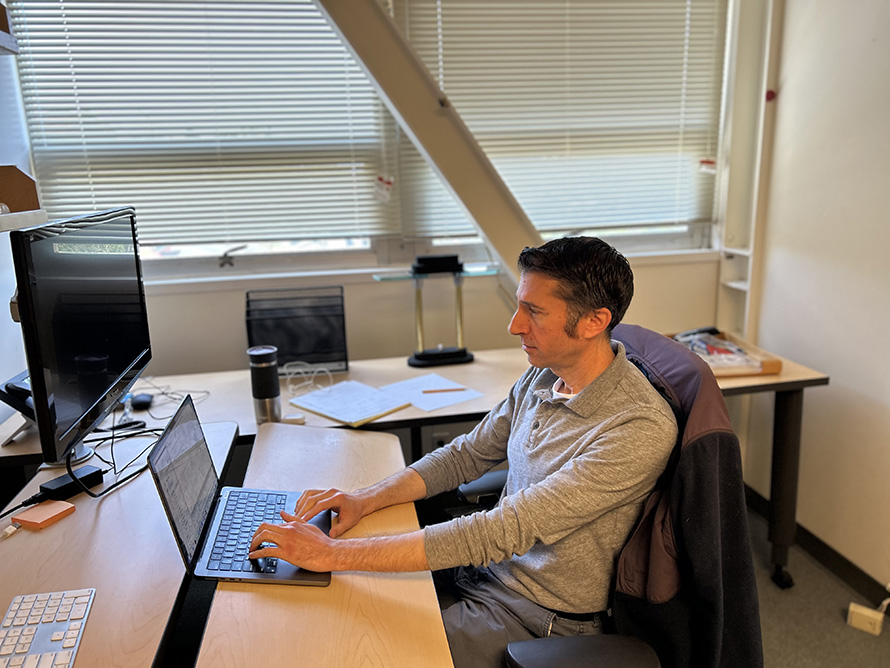Chad Mitchell joined Lawrence Berkeley National Laboratory (Berkeley Lab) in 2012. He is a staff scientist in the Advanced Modeling Program within Berkeley Lab’s Accelerator Technology & Applied Physics (ATAP) Division. Originally from North Carolina, Chad holds a Ph.D. in physics from the University of Maryland at College Park, where his research focused on computational particle accelerator physics. In 2016, Chad received a Department of Energy Early Career Research Program award to study the interplay between nonlinear dynamics and space charge in designing novel focusing schemes for high-intensity accelerator facilities. This research ultimately led to a Lab Director’s Award for Scientific Achievement in 2021.
What fueled your interest in particle accelerators and their applications?
My interest in particle accelerators arose indirectly through the mathematical techniques used to study them, and I had considered pursuing a graduate degree in mathematics. However, as a physics graduate student, I came across a copy of a manually printed book titled “Lie Methods for Nonlinear Dynamics with Applications to Accelerator Physics” by one of our faculty members. I was captivated by the idea that advanced, rigorous mathematics could be used to design real facilities at the forefront of physics discovery.
Even now, what appeals to me most is the interdisciplinary nature of the accelerator field, which combines various areas of physics, mathematics, and high-performance computing.
What attracted you to join ATAP’s Advanced Modeling Program?
When I first joined the lab, ATAP’s Advanced Modeling Program and the Berkeley Accelerator Controls & Instrumentation Program were part of a unified Center for Beam Physics (CBP). This internationally recognized center of expertise in accelerator beam dynamics provided an excellent learning opportunity for a postdoctoral researcher at that stage of my career.
 At that time, there was also significant enthusiasm for designing potential next-generation light sources, such as an X-ray free-electron laser (XFEL), at the Lab. This enthusiasm eventually evolved into a successful collaboration with SLAC National Accelerator Laboratory, which included members of CBP and the Lab’s Advanced Light Source, focusing on the modeling and design of the Linear Coherent Light Source II XFEL, for which I was grateful to be involved.
At that time, there was also significant enthusiasm for designing potential next-generation light sources, such as an X-ray free-electron laser (XFEL), at the Lab. This enthusiasm eventually evolved into a successful collaboration with SLAC National Accelerator Laboratory, which included members of CBP and the Lab’s Advanced Light Source, focusing on the modeling and design of the Linear Coherent Light Source II XFEL, for which I was grateful to be involved.
How have you found working at the Lab, and what research are you working on?
Working here is both rewarding and challenging. The level of scientific expertise and the commitment to supportive collaboration foster a stimulating environment for creative ideas.
I currently spend part of my time working with a team led by AMP Research Scientist Axel Huebl to develop a code called ImpactX within the Beam, Plasma, & Accelerator Simulation Toolkit, a suite of codes and standards developed by an international collaboration led by AMP. ImpactX is designed for the start-to-end modeling of beam transport with collective effects through complex accelerator systems, supporting the latest high-performance computing architectures as well as Artificial Intelligence and Machine Learning tools.
The remainder of my time is dedicated to modeling and understanding beam dynamics in accelerator facilities at the Lab and beyond, supported by various projects. This encompasses algorithm development as well as general research and development in beam physics related to nonlinear dynamics and space charge, aimed at enhancing the modeling and quality of high-intensity beams.
For more information on ATAP News articles, contact caw@lbl.gov.
